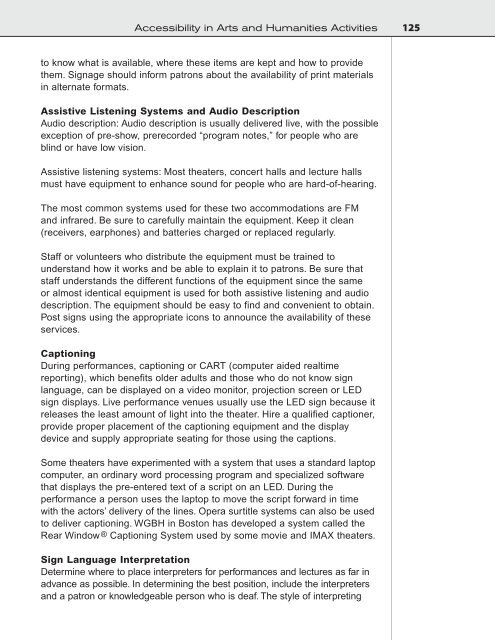Design for Accessibility: A Cultural Administrator's Handbook
Design for Accessibility: A Cultural Administrator's Handbook
Design for Accessibility: A Cultural Administrator's Handbook
Create successful ePaper yourself
Turn your PDF publications into a flip-book with our unique Google optimized e-Paper software.
<strong>Accessibility</strong> in Arts and Humanities Activities 125<br />
to know what is available, where these items are kept and how to provide<br />
them. Signage should in<strong>for</strong>m patrons about the availability of print materials<br />
in alternate <strong>for</strong>mats.<br />
Assistive Listening Systems and Audio Description<br />
Audio description: Audio description is usually delivered live, with the possible<br />
exception of pre-show, prerecorded “program notes,” <strong>for</strong> people who are<br />
blind or have low vision.<br />
Assistive listening systems: Most theaters, concert halls and lecture halls<br />
must have equipment to enhance sound <strong>for</strong> people who are hard-of-hearing.<br />
The most common systems used <strong>for</strong> these two accommodations are FM<br />
and infrared. Be sure to carefully maintain the equipment. Keep it clean<br />
(receivers, earphones) and batteries charged or replaced regularly.<br />
Staff or volunteers who distribute the equipment must be trained to<br />
understand how it works and be able to explain it to patrons. Be sure that<br />
staff understands the different functions of the equipment since the same<br />
or almost identical equipment is used <strong>for</strong> both assistive listening and audio<br />
description. The equipment should be easy to find and convenient to obtain.<br />
Post signs using the appropriate icons to announce the availability of these<br />
services.<br />
Captioning<br />
During per<strong>for</strong>mances, captioning or CART (computer aided realtime<br />
reporting), which benefits older adults and those who do not know sign<br />
language, can be displayed on a video monitor, projection screen or LED<br />
sign displays. Live per<strong>for</strong>mance venues usually use the LED sign because it<br />
releases the least amount of light into the theater. Hire a qualified captioner,<br />
provide proper placement of the captioning equipment and the display<br />
device and supply appropriate seating <strong>for</strong> those using the captions.<br />
Some theaters have experimented with a system that uses a standard laptop<br />
computer, an ordinary word processing program and specialized software<br />
that displays the pre-entered text of a script on an LED. During the<br />
per<strong>for</strong>mance a person uses the laptop to move the script <strong>for</strong>ward in time<br />
with the actors’ delivery of the lines. Opera surtitle systems can also be used<br />
to deliver captioning. WGBH in Boston has developed a system called the<br />
Rear Window ® Captioning System used by some movie and IMAX theaters.<br />
Sign Language Interpretation<br />
Determine where to place interpreters <strong>for</strong> per<strong>for</strong>mances and lectures as far in<br />
advance as possible. In determining the best position, include the interpreters<br />
and a patron or knowledgeable person who is deaf. The style of interpreting


